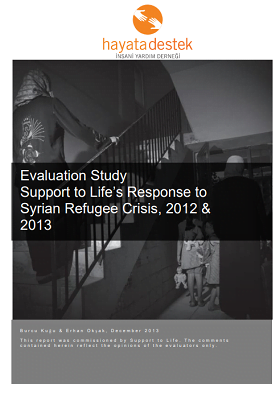Evaluation Study Support to Life’s Response to Syrian Refugee Crisis, 2012 & 2013
This report is part of enhancing Support to Life’s organisational learning on its Syrian Refugee Programme in Turkey. The specific objective of the evaluation is to present the findings on the achievements, quality and overall impact of Support to Life’s humanitarian response of the Syrian refugee crisis in Turkey. Adding to that, this report intends to identify lessons learned and develop recommendations that will assist STL management to build capacities into future programming in order to help communities better cope with risk and to enable a more timely and appropriate response to the continuing humanitarian crisis. The evaluation exercise was undertaken in December 2013 in Hatay by two external consultants.
A context assessment is presented as background information, including the needs and capacities of the Syrian refugees and other actors involved. An introduction to the methodology, scope and limitations, the current report presents the main and relevant findings of the evaluation. The findings are presented in four sections, namely programme achievements, programme management, organisational culture and capacity, and partnerships. Going beyond that, the findings based on the OECD/DAC criteria, are discussed further in detail in a cross-sectorial manner, from which an overall analysis and recommendations are presented in the last section.
The study should be recognized as a real-time evaluation for STL’s on-going projects. This evaluation report seeks to capture perceptions of refugee community members with respect to STL’s programmes. Further investigate and analysis of STL activities on the ground resulted in an understanding of the effectiveness and efficiency of projects, and their relevance to the need of the affected populations. The intended audience for the report varies from STL management to partner organisations, including donors and other stakeholders, which might include policy makers.
